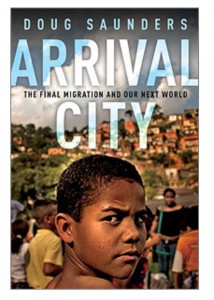Rural poverty in China, India, Africa, and Latin America is a modern tragedy. Deep poverty seems understandable in 1800 or 1900, but how could so many billions remain poor by 2000 or 2015?
Migration is the fastest, surest path out of poverty. Cubans, Haitians, Mexicans, and Chinese who moved from rural areas in their country to the United States quickly prospered compared to friends and family who stayed home. Marginal Revolution University’s Tyler Cowen explains why in “Wage Gains from Immigration.”
Borders prevent most migration from poor to wealthy countries, but rural migrants can still improve their lives migrating to cities, edge cities (and “shanty towns”) in their own countries.
Arrival City reports on this migration around the world, and the website features a short video from one of China’s arrival cities:
In this multimedia presentation, Doug Saunders and photographer Sun Shaoguang take you inside Liu Gong Li, the haphazard, improvised neighbourhood on the edge of Chongqing that opens the first chapter of Arrival City, and introduce you to some of the book’s personalities.
Arrival City on Amazon (website book link seems broken).
China’s “floating population” of migrant workers still lack rights of other Chinese workers, but as China’s wage levels have increased so have migrant worker’s incomes. “5 Things to Know… About China’s Floating Population,” (Paulson Institute, November 13, 2015) notes:
The composition of China’s floating population, now numbering around 274 million, has changed over the past 30 years. Today, 19.3% have college degrees. With two-thirds of this floating population consisting of people under the age of 35, the floating population has accumulated a larger proportion of millennials, who are earning higher educational degrees and entering a more diverse range of industries and occupations.
The low wages reports at the Chinese shoe supplier for Ivanka Trump (see previous post: “China’s Factory Workers: Exploitation or Escape from Rural Poverty?“), likely reflect the income disparities even among migrant workers.
There is significant income disparity within the floating population, with the top 20% earning 3.8 times more than the bottom 20%. Migrant workers are no longer restricted to the low-end segment of the labor market. And the influence of government regulation on migrant incomes has diminished: migrant income is now more dependent on human capital and social connections.
“Human capital” refers to the skills of individual workers. Growing up in deep poverty in rural China today, as through all time, does not equip young people with skills. Only with they migrate to factory towns or edge cities, or when factories relocate to rural areas, are they able to learn skills to earn higher wages.
The Paulson Institute’s “How to Better Support China’s Migrant Population,” (November 11, 2015) reports on China’s floating population and the government reforms that would improve their lives.
Institutional reform is the key to development. Globalization (access to global capital and markets) can expand opportunities, but only if the local legal systems allow it.
Raluca Șancariuc explains in “State-Building and Breaking,” a review of “Why Nations Fail: The Origins of Power, Prosperity, and Poverty” by Daron Acemoglu and James Robinson:
Their explanation for why some countries are poor while others are prosperous has institutional foundations: it is the quality of the institutions underlying economic and political life that influences wealth accumulation. The authors create a sharp distinction between inclusive institutions, which encourage productivity, education, technical progress, and extractive institutions, which only take wealth away from one part of the society, for the benefit of the other. It is the former type of institutions that support the creation of wealth inside of a nation even beyond the world knowledge frontier. When the country is playing at catch-up growth, extractive institution might see it through to some stage of development, but it will inevitably falter, as true competition and an appropriate supply of public goods comes from inclusive institutions.
